Up Next

There were times during the Turkish Grand Prix when Lewis Hamilton’s Mercedes was 5s slower than the opposition. Yet there was always evidence that he was set for victory if he just stuck to a plan and let the race come to him.
Mark Hughes explains.
The Temperature Framework
Behind Lewis Hamilton’s sealing of a seventh world championship with a superb drive to victory was an extraordinarily complex set of equations.
Those same sums were what had left him only sixth fastest in qualifying and were responsible also for the remarkable field spread – that sixth-fastest time was a full 5.5 seconds slower than Lance Stroll’s pole in the Racing Point.
Something was happening here. For what it’s worth, it was actually quite clear and explainable. This was a track – resurfaced just 10 days before Formula 1’s arrival – so extreme in its lack of surface grip that it wildly exaggerated the effects of different car traits in how they used the tyres.
Mix that in with variable weather conditions and that form swing-ometer was all over the place. The correct tyre temperature is a switch-like threshold rather than a progressive scale. The difference either side of that threshold was well over five-seconds.
Which meant there wasn’t one definitively fastest car. It depended upon what the conditions were at any given moment. Hence the circumstances were perfect for Racing Point in qualifying, very bad for Mercedes, with Red Bull somewhere in between.
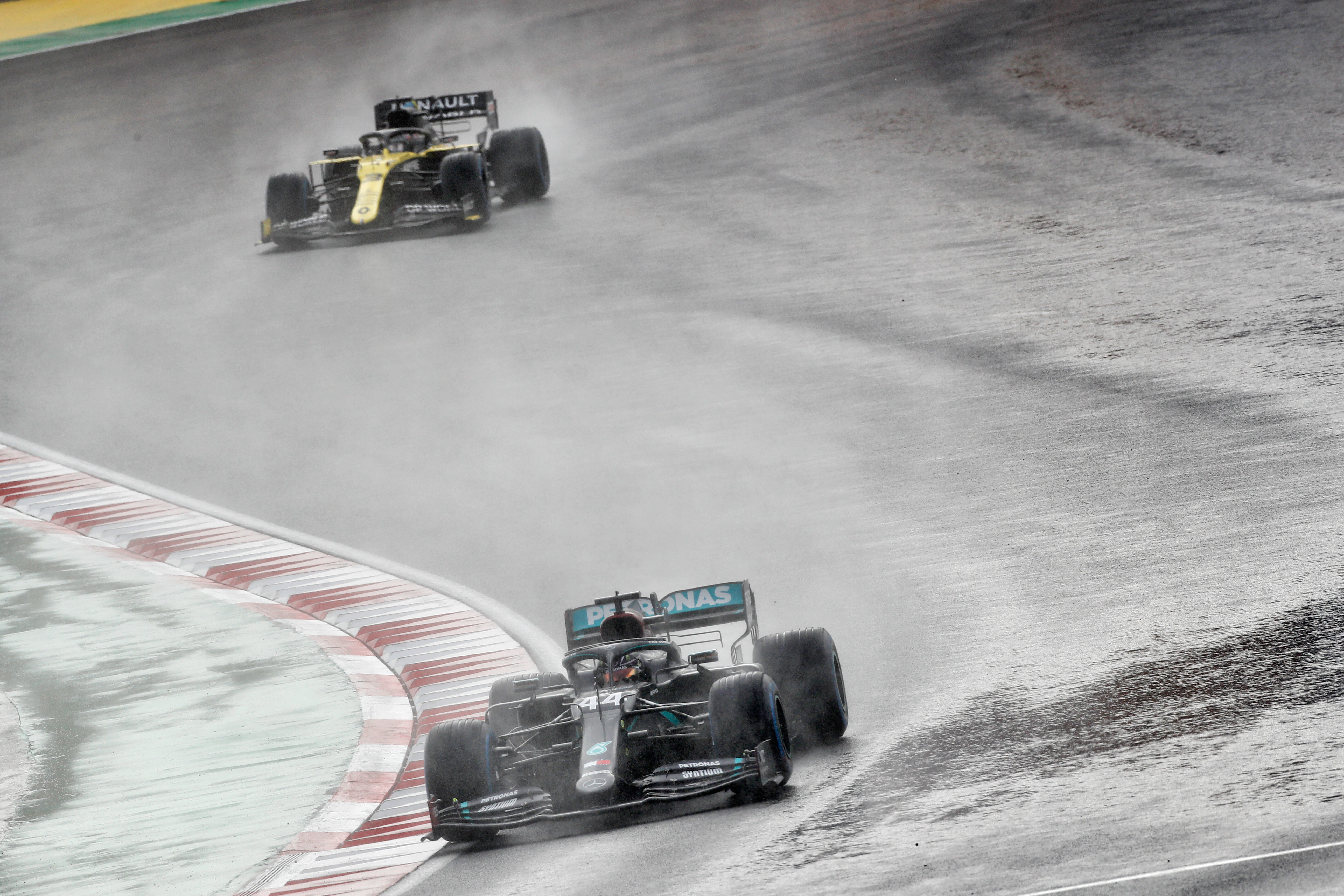
But on race day, conditions and circumstances came to Mercedes. Eventually.
It took a while for that to play out. Simply because the Mercedes was taking around seven laps to get its rear tyres in the temperature window. In qualifying you don’t have the luxury of seven consecutive laps.
Had the race been a safety car fest, or a wet-dry-wet affair, then conditions would almost certainly have punished Mercedes again, just as they had on Saturday.
What seemed to be apparent from the outside wasn’t actually what was happening. This race was never really a contest between the Racing Points and Red Bulls
But remarkably, there were no safety cars – and once the initial short wet-tyred period was over, the track remained forever on the cusp between inters and slicks. Which was perfect for Mercedes. For had they needed to stop, it would have taken another seven-lap cycle to get the performance – while the Racing Points and Red Bulls would have pulled away all over again.
Sewing all those tricky variables together to make what had initially looked like an open, ripped-apart garment of a race, was Hamilton.
What seemed to be apparent from the outside wasn’t actually what was happening. This race was never really a contest between the Racing Points and Red Bulls, despite the early stages – Stroll leading Sergio Perez, with Max Verstappen catching – making it look that way.
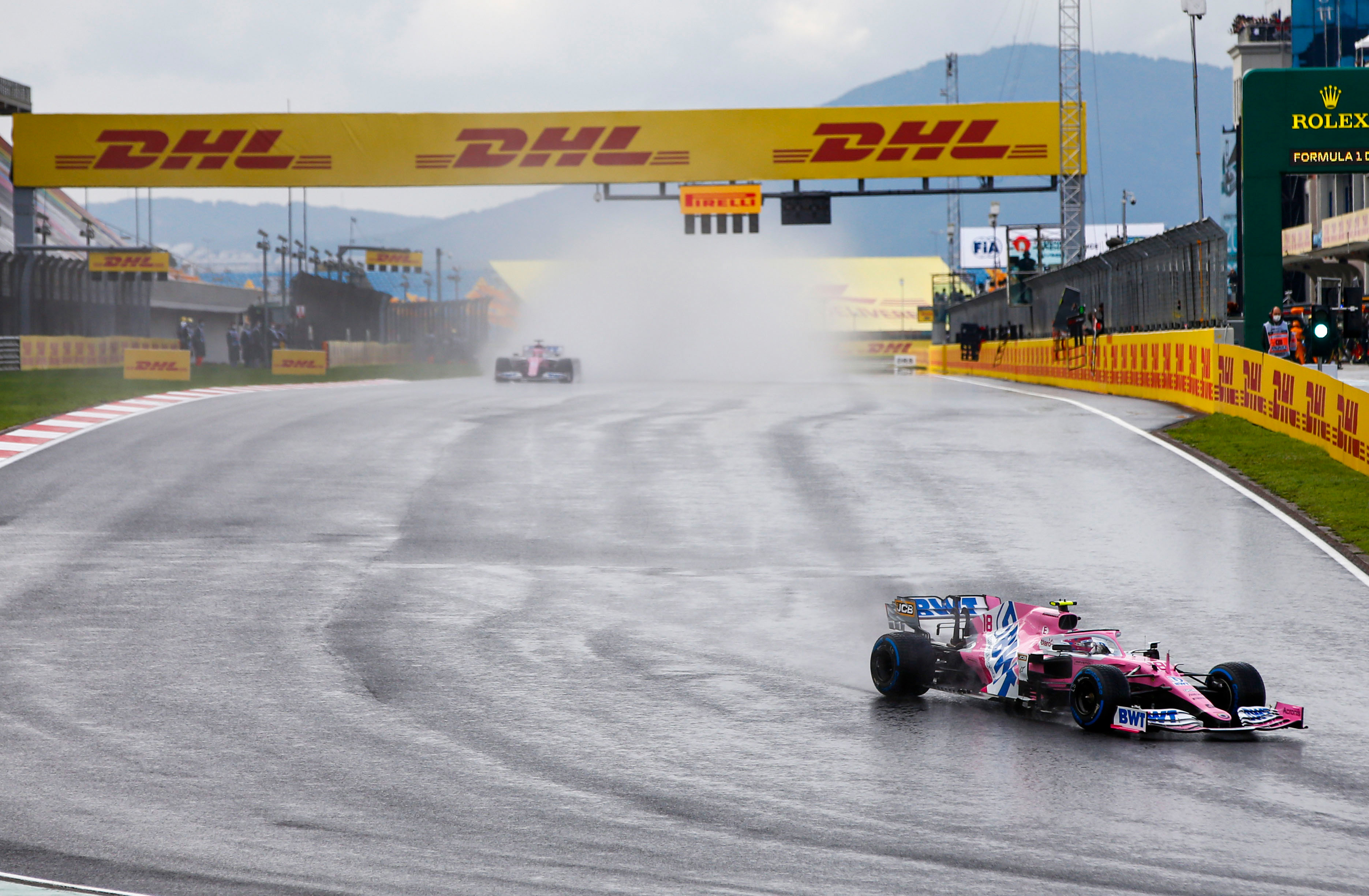
It was only ever a question of how far the others would be ahead of Hamilton by the time his tyres came in. And what he could do about eradicating that gap before the end. Hamilton’s race was one of initial patience and subsequent superb judgement.
The others took care of themselves and he won by half a minute. Thanks to no safety cars, no on-off showers of rain. Enough to get Hamilton’s tyres up and working and allowing them to stay there.
The rivals – Racing Point and Red Bull – were by contrast reacting to events in front of them, preoccupied in racing each other. Which just made their defeat by Hamilton’s Mercedes even more inevitable.
There’s the energy you put into the tyre, and that which you take out through using the grip. You put it in by way of vehicle dynamics, the way the load is induced into the tyre, sudden or progressive, the balance between the two ends of the car.
The wheelbase plays a part in this and the Mercedes remains the longest wheelbase car in the field, and the load transfers will be less abrupt.
Also, the downforce flattens the tyre, so the more of it you have, the more evenly the load is spread across the tyre. Which can reduce its initial response, with lower localised spike loadings. Which means that it can take longer to get up to temperature.
Every time Bottas spun he’d lose all the tyre temperature he’d just spent many laps building up
But by the time it gets there, far less has been taken from the tyre and it’s ready to go as the rivals are wilting.
In normal conditions this difference plays out in less than a lap. You’ll see it in the way a Mercedes needs a more aggressive out-lap in qualifying than a Red Bull, for example.
But here that process lasted for many laps, because of the extreme low-grip conditions and the threshold nature of the mechanism. So that’s why the elastic between the Racing Points at the front and Hamilton somewhere distant behind stretched, then contracted.
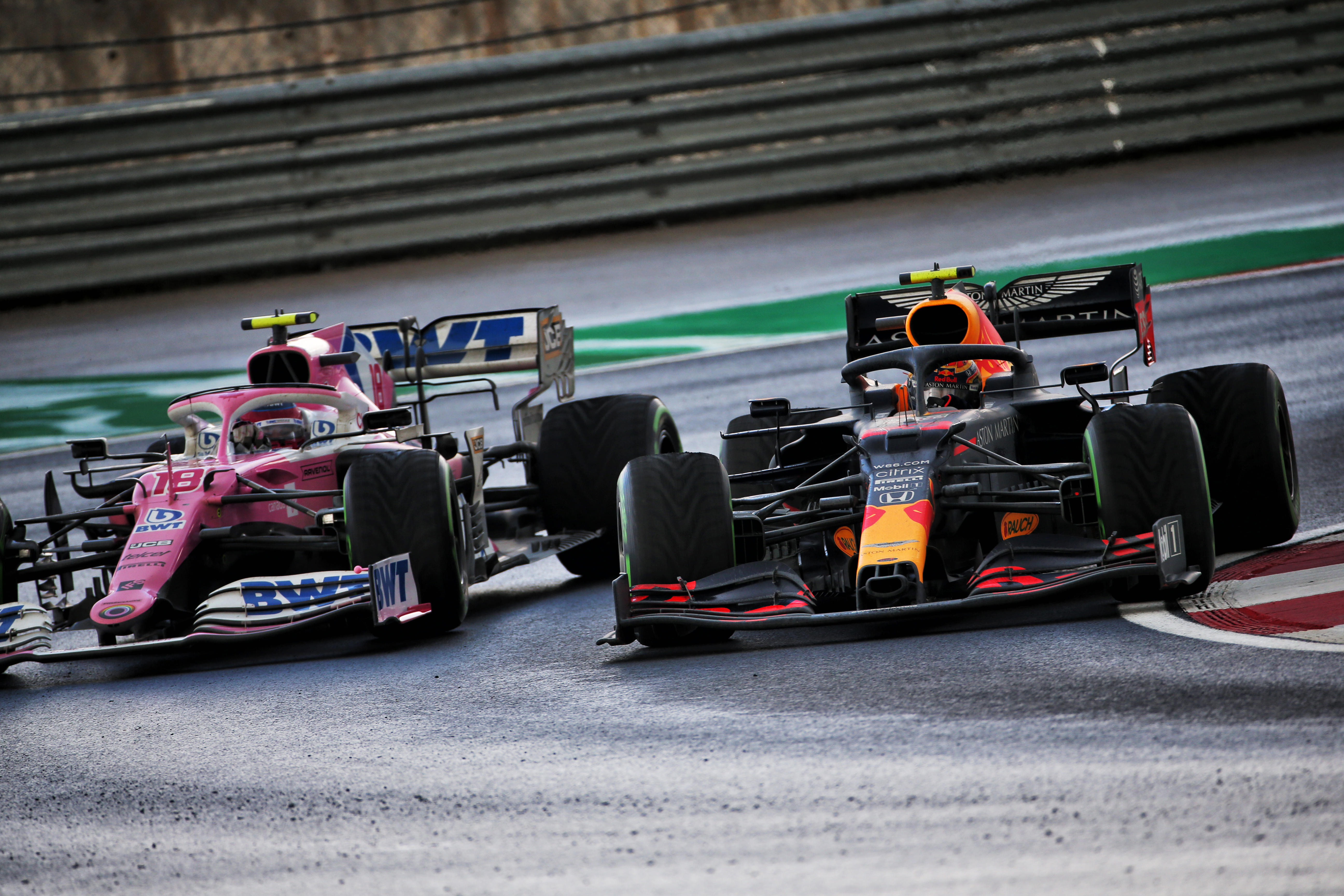
The gap between the Racing Points and the Red Bull did the same but was far less accentuated, a less exaggerated version of the same process. The various dramas of Stroll, Perez, Verstappen and Alex Albon played out within that basic framework. It was not at all like a conventional race.
What that all means is that Hamilton was in the fastest car once its tyres were in the window – and all he had to do was execute perfectly, hope there were no safety cars and the race would come to him. Not easy but he did it near-perfectly.
Valtteri Bottas in the sister car had what he describes as the most difficult race of his career and was lapped by Hamilton on his way to a lowly 14th place finish.
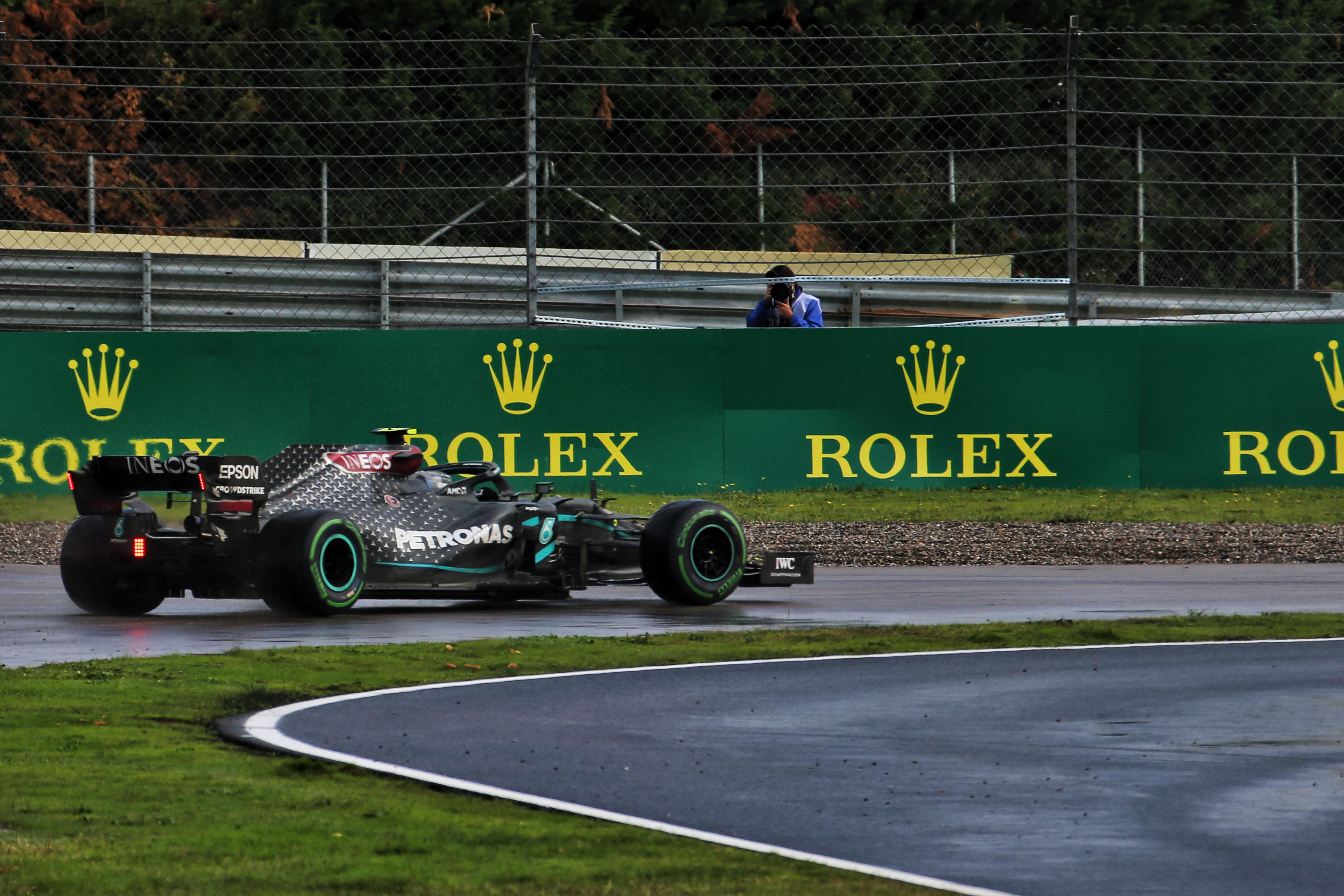
But that’s not comparing like with like. His lap one collision with Esteban Ocon’s Renault at Turn 9 damaged his steering and front wing. That meant he was running out of lock to correct rear slides. Which is why he spun six times.
And every time he spun he’d lose all the tyre temperature he’d just spent many laps building up. So he’d have to start again from scratch. That’s 49 of the 58 laps he spent out of the tyre temperature window. He had them back in by the end, when he set the second-fastest lap of the race.
When you’re out of the tyre temperature window, you are whole seconds slower than cars within it – as qualifying had demonstrated. Bottas’s race and how it contrasted with Hamilton’s just underlined how the factors determining performance were wildly different from usual in this race.
Within the framework

Here’s how it played out.
Rain had soaked the track around and hour-and-a-half before the start. Extreme wets for everyone – apart from the two pitlane-starting Williams. George Russell had a ‘walking speed’ collision with the pitlane wall when pitting from an exploratory lap and crunched the nosecone.
The lack of grip off the line was almost comical. Particularly cartoon-like were the Red Bulls, which just sat there, almost motionless, while their rear wheels spun wildly. The Racing Points had much better drive, so Stroll was into an immediate lead from Perez – and they were gone.
Behind them, Verstappen and Albon were swamped by both Renaults and both Mercedes. There wasn’t room for the four of them through that tight Turn 1. Ocon squeezed Daniel Ricciardo between himself and Hamilton on the inside, causing the Renaults to touch, spinning Ocon around into Bottas’s path.
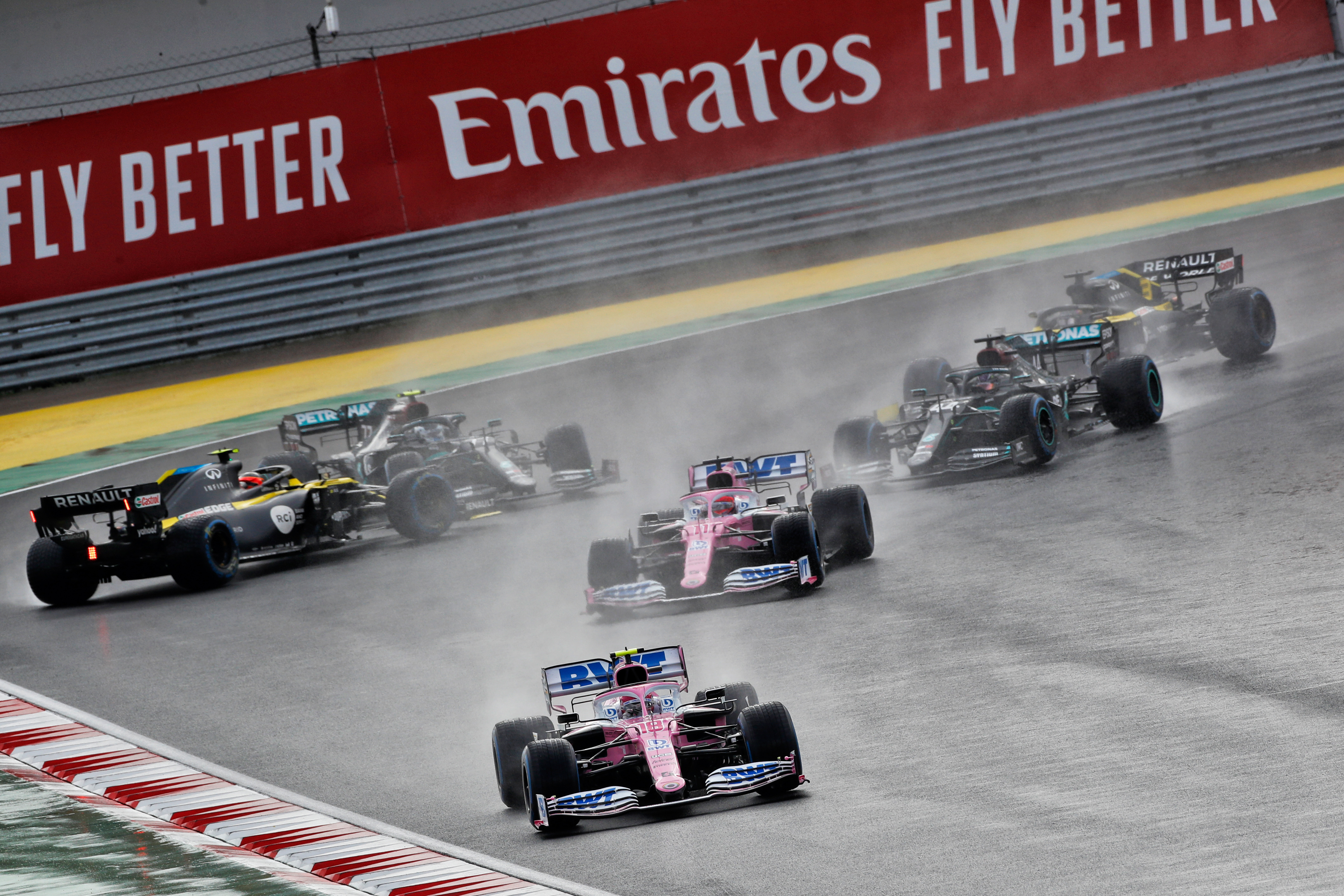
Hamilton survived to go third, with Ricciardo next but about to be passed by both Sebastian Vettel – who’d got a relative flyer of a start – and Verstappen, who’d finally got some momentum. Ricciardo was then demoted a further place at Turn 4 by Albon.
Bottas, after spinning onto the run-off apron restarted well down but was quickly catching the pack into the Turn 9 chicane. He had to beat Hamilton in this race if he was delay the title formalities for another day so was in no mood to tread carefully. On the even more gripless inside line he locked up – and hit Ocon. The damage from which would give him the nightmare race already described.
Hamilton had also locked up at Turn 9 and took to the escape lane, allowing Vettel and Verstappen to stream past, dropping Hamilton to fifth. On his cold rears, he then locked up again into 12 and was passed by Albon.
That was probably a blessing in disguise, for it saved him having to defend from cars which heated up their rubber quicker and were initially faster. This way, he could just drive cleanly, build up that crucial temperature in the rears – which the team knew was going to take several laps. Even if Lewis didn’t necessarily share their confidence as he watched the top five streak away from him.
Stroll, the only one not impeded by the spray cloud, was 5.3s in front of team-mate Perez by the end of the second lap and appeared to have everything under control, driving with impressive assurance in the treacherous conditions. A big gap then to Vettel, a barrier the Red Bulls couldn’t pierce.
It stayed that way until Vettel was brought in for his intermediates after eight laps. Ferrari did this after having done the same for Charles Leclerc from 14th and watched him set purple sector times immediately.
“I could see Albon pulling away and I thought, ‘Jesus, this race is falling through my fingers'” :: Lewis Hamilton
Mercedes responded to the Leclerc times too, bringing Hamilton in on the same lap as Vettel. It seemed about the right time to switch. Racing Point brought Stroll in from the lead next lap and Perez the lap after.
But Verstappen – remembering very clearly how the Red Bull had not liked the inters the day before and how good it was on the wets – cautioned, “Let’s not go too early with the inters.”
Once Vettel had pitted out of his way, his pace on the wets was fantastic – around 0.7s quicker than Vettel was going on his inters. He came in on lap 11 – and got out now ahead of the Ferrari.
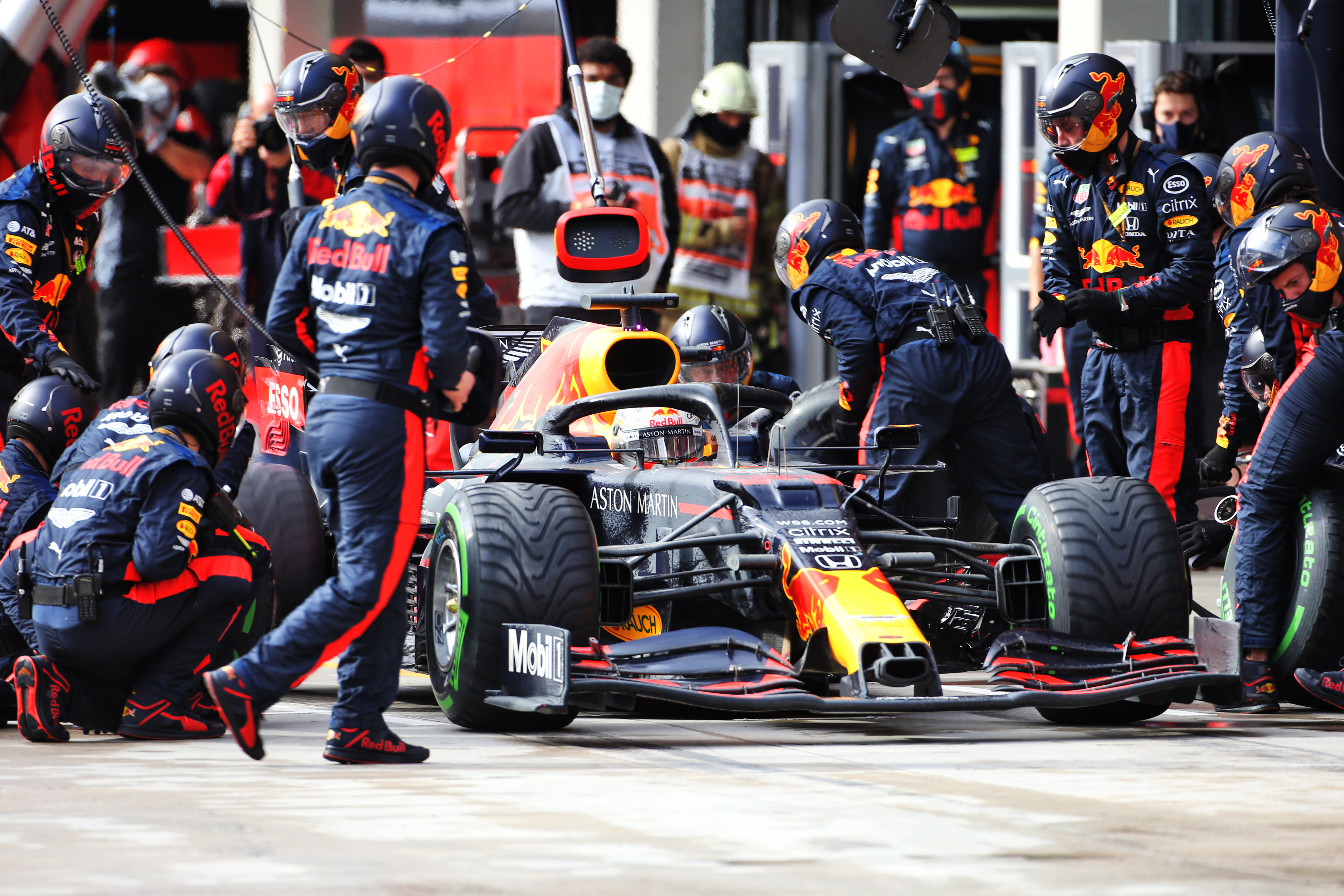
Albon wasn’t quite as quick and the extra lap he ran in the lead, still on wets as the track improved, lost him a place to Hamilton.
With everyone now on inters, Stroll led Perez by 9s, with Verstappen third, now lapping a couple of seconds slower than Stroll, as the Red Bull was again slower to warm up the new rubber than the Racing Point. The Mercedes was even slower – Hamilton initially five seconds slower than the Racing Point once more, just as in qualifying.
Here was that tyre warm up mechanism again. In the first stint, on wets, Hamilton had initially been five seconds slower too. His speed deficit reduced each lap until after seven laps he’d begun lapping faster than Stroll.
Mercedes politely ignored Hamilton. It had a fuller picture than he could have from the cockpit
Now he was having to start that process all over again and he was a full pit stop’s-worth of time adrift of Stroll. A VSC on lap 14-15 for Antonio Giovinazzi’s broken down Alfa Romeo just delayed the process further. He was almost immediately ambushed on his still-cold tyres by Albon who then made quick work also of Vettel.
Once everyone’s tyres were up to temperature, the real performance potential of the cars became the dominant factor – and hence Verstappen was quickly catching the Racing Points. Once he got onto the tail of Perez, so Albon was catching up with them.
This was looking good for Red Bull. On the 18th lap Perez went into the Turn 9-10 chicane a little too deep, was slow through there and Verstappen got tight into his slipstream and stayed there as they headed through the fast kink that follows.
LAP 18/58
HUUUUGE moment for Max 🤯
He gets wayward in Perez's spray and spins, flat-spotting his tyres#TurkishGP 🇹🇷 #F1 pic.twitter.com/oIKvVJkofW
— Formula 1 (@F1) November 15, 2020
Trying to swap to the other side of the Racing Point, Verstappen lost downforce, got out onto the slippery painted area and spun at high speed. He got going again on flat-spotted tyres and made his way to the pits for replacements, promoting Albon to third and closing on Perez.
As Hamilton’s tyres finally came in, so he quickly recovered the gap that Vettel had pulled out over him. But he could find no way by the Ferrari.
Hamilton became frustrated as the Racing Points and Red Bulls pulled away while he was restricted to Ferrari pace.
“I could see Albon pulling away and I thought, ‘Jesus, this race is falling through my fingers.’”
He pleaded with his pitwall to try something with strategy. They politely ignored him. They had a fuller picture than he could have from the cockpit.
Vettel was doing a great job, but with everyone’s tyres now up to temperature, the Ferrari was lapping probably over 1s slower than Hamilton was capable of going. Regardless, the fastest way to run Hamilton’s race was to just keep going.
“There was a point at which Seb was pulling away from me and I couldn’t figure out at the time what it was,” he said.
“I was checking my temperatures. I didn’t know if it was because the tyres were overheating or they were too cold. They went through a drier patch.
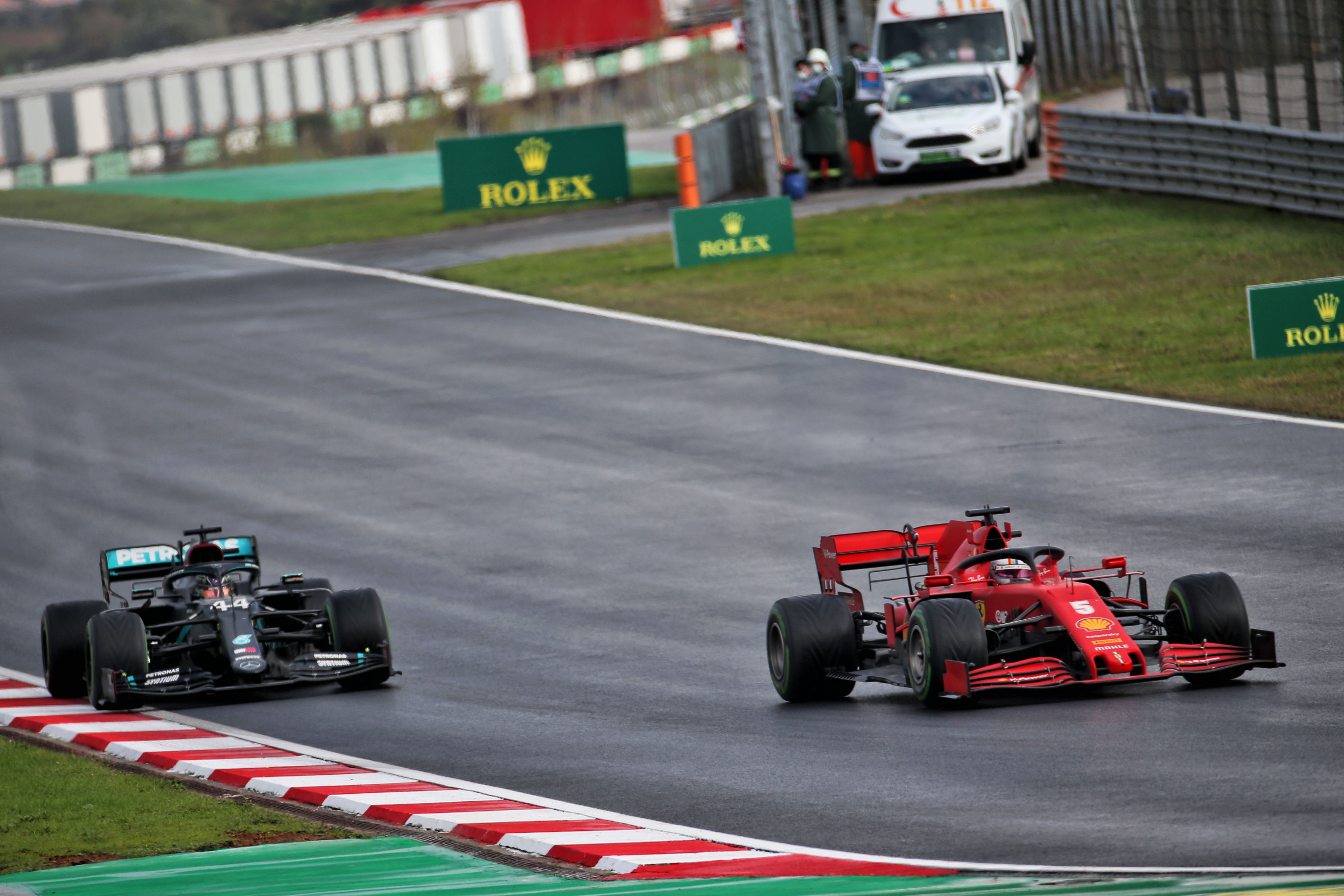
“I went through the real rough phase of the graining on the tyres and then it started to come back, the grip started to come back. The track was drying in some areas and I was improving my driving lines the whole way through the race and I started to pick up pace.”
Ferrari brought Vettel in for another set of inters on the 33rd lap of 58, having three laps earlier done the same for Leclerc and seen his subsequent speed. The Ferrari gets heat into the tyres well, as was seen at the Nurburgring, but isn’t as aggressive on the fronts as the Racing Point or Red Bull and Vettel was quick as he rejoined.
“You can just hear the change in tone of his voice. As soon as the voice gets into that calm state you know he’s now in control” :: Pete Bonnington
But Hamilton, freed from Vettel at last, could now tell that for him, stopping would be the wrong strategy.
“Yes, by then the tyres had worn down so nicely,” he explained. “As they got more slick that’s exactly what you needed. And the inter was holding the temperature.”
Besides, coming in for a fresh set would entail another seven laps getting them back up to that temperature.
Hamilton began to launch his attack now and was soon gaining on Albon.
“You can just hear the change in tone of his voice,” said Hamilton’s engineer Pete Bonnington afterwards. “As soon as the voice gets into that calm state you know he’s now in control.”
What had been a pit-stop’s-worth of deficit to Stroll was now under 9s and reducing. Now the strategy was making sense to Hamilton.
With his tyres up to temperature, all he needed was some clear track and he was going to catch them all. Beyond Albon were the Racing Points and he was lapping faster than any of them.
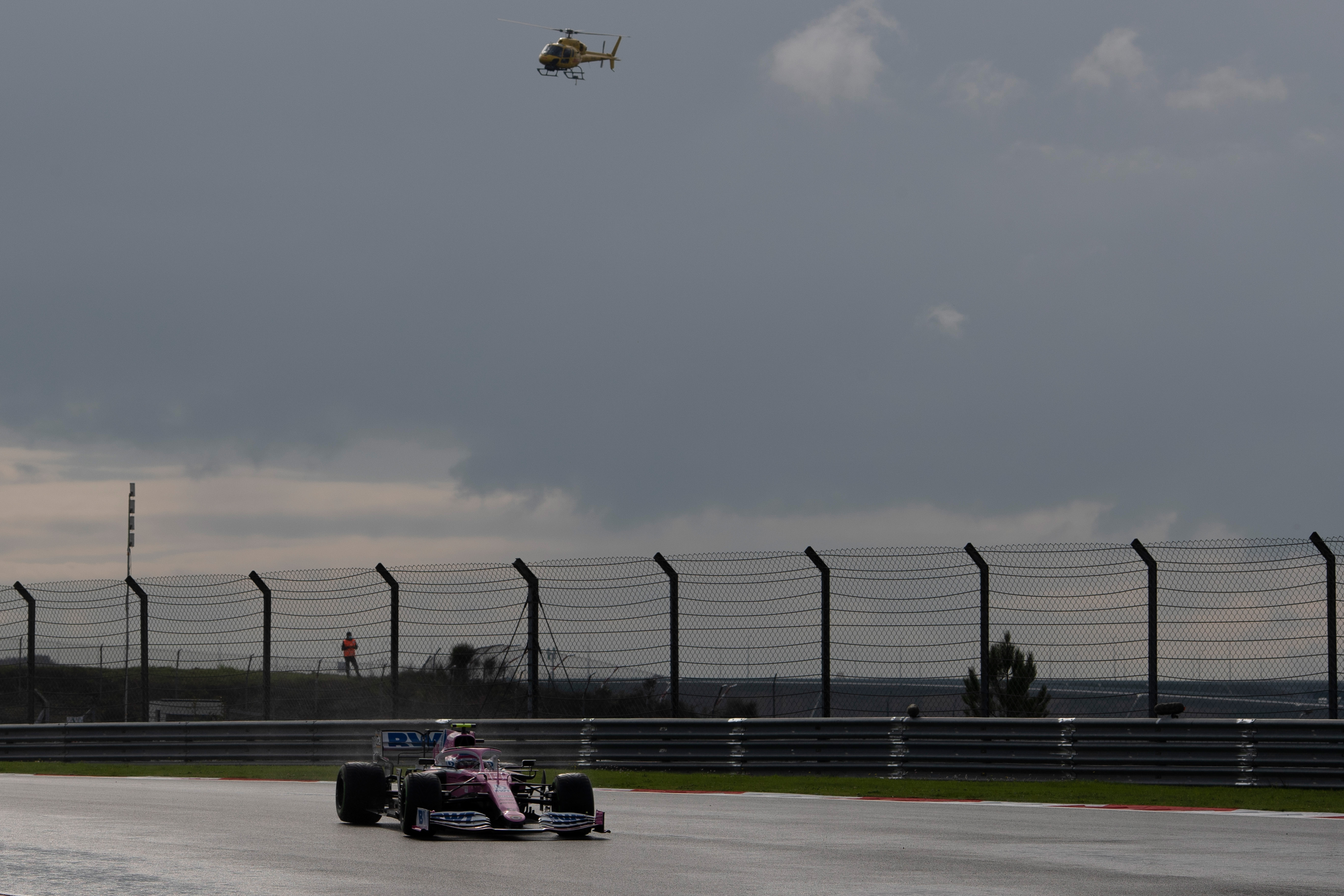
Meanwhile, Stroll’s earlier scintillating pace was beginning to drop off. Most teams were planning around a forecasted rainfall late in the race and were keen therefore to extend the stint into a possible changeover to slicks.
As such, the Racing Point pitwall probably needed to have controlled Stroll’s early pace a little more than they did. That earlier 9s lead over his team-mate was down to 2s by the 33rd lap. The team said the following day that it later discovered damage to Stroll’s car that would’ve contributed to the tyre graining he suffered.
It looked like the rain wasn’t coming, after all, but Stroll and Albon were now running out of rubber and Hamilton was catching. Albon’s tyres had given up completely by the 34th lap and he spun exiting the damp Turn 4.
Stroll and Albon no longer figured in the destiny of this race. They’d shot their bolt
Hamilton flashed by as Albon made his way to the pits for replacement rubber. He rejoined behind the earlier-pitting Leclerc but had no great pace as the new inters quickly grained.
It was an experience about to be repeated by the leader Stroll. He pitted from the lead on the 36th lap. The track was drier now but not dry enough for slicks, particularly in the last sector.
Stroll had been out there for only a lap when he radioed in that his new inters had grained immediately. They did so more disastrously than Albon’s and the Red Bull was able to pass. But neither were a threat to Leclerc ahead and both would be subsequently passed by Carlos Sainz Jr’s McLaren.
Brand new inters on a much drier track will tend to rip themselves to shreds. Whereas inters that have been progressively worn from a wetter track will remain nicely consistent as the tread wears itself down to a near-slick.
It’s of a softer compound than the actual soft slick too, so making it perfectly suited for the cool track temperature. Looking after that first set, not asking too much of them, was the ideal way to run this race, with the track remaining just on the inters side of the cusp.
Stroll and Albon no longer figured in the destiny of this race. They’d shot their bolt.
Perez had been about to pit for a fresh set when his engineer informed him of Stroll’s graining experience. So that plan was abandoned. He, like Hamilton, would run to the end on this set.

The track was by now dry enough for DRS to have been enabled – and Hamilton used his to slipstream past Perez for the lead on the 36th lap.
As he pulled away from the Racing Point at around 2s per lap, he was still careful to nurse that crucial right-front. The performance order had now played out, with the fastest car at the front and pulling away, despite its old tyres. Because new inters were too brittle, old tyres were exactly what was required in this instance. Just so long as you hadn’t taken too much from them too early.
Verstappen had been briefly very fast on his replacement inters, but too much so for the Red Bull’s aggressive use of them. He’d be in the pits for a third time on the 42nd lap, rejoining seventh, behind Albon and 40s adrift now of Hamilton.
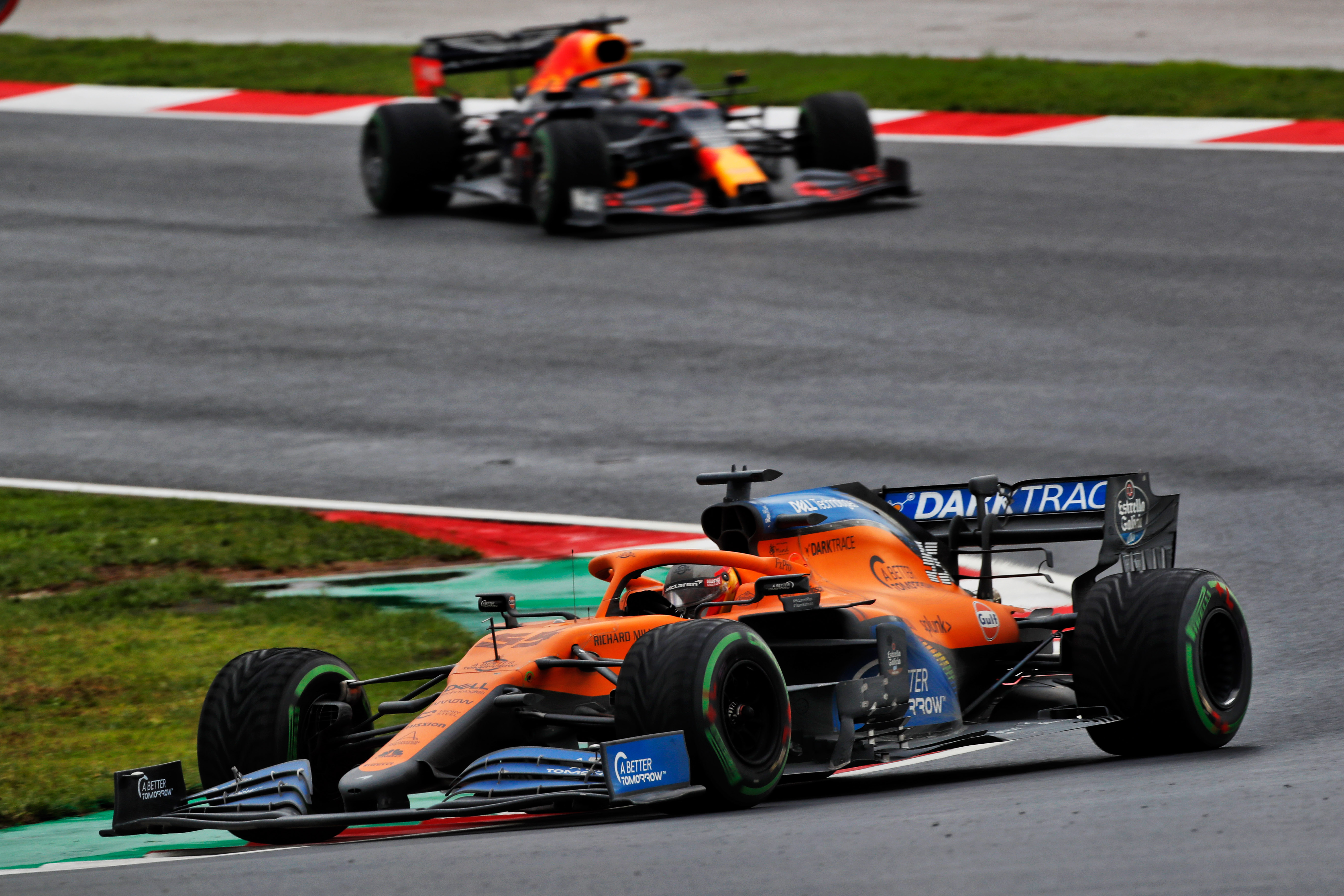
Albon would subsequently move aside for Verstappen but they could make no inroads on Sainz’s fifth place. The McLaren was working its tyres superbly and Sainz’s performance was being mirrored a few places back by team-mate Lando Norris who was soon past Ricciardo and the struggling Stroll – and chasing down Albon, setting fastest lap along the way.
Lando would improve on that benchmark on the final lap to take the extra point that goes with it, but he remained behind Albon, in eighth. Stroll and Ricciardo, both struggling with their tyres at the end would be the last two points scorers.
As Perez desperately eked out his tyre life, so the newer-tyred Ferraris were catching him. Vettel had been asking to gamble on a change to slicks about 10 laps from the end.
“It might have been possible to win, doing that,” he said. “But the team was reluctant. I can understand that they wanted to keep what they had.”
There was also the forecast of rain on the last lap. Mercedes had called Hamilton in for a precautionary change to fresh inters just in case that forecast came true. But Hamilton overruled it. He’d lost one championship in a slippery pitlane before and didn’t want to risk it.
Leclerc had caught and passed Vettel but Seb had stayed right with him as they both hunted down the Racing Point. Hamilton had already taken the victory chequer as this trio – joined now by Sainz – squabbled through the final lap.
The final lap really said 🔀📈📉📈📉🔀 😳#TurkishGP 🇹🇷 #F1 pic.twitter.com/sReBo2xTRQ
— Formula 1 (@F1) November 15, 2020
Perez suffered a lock-up into the chicane and as he ran wide was passed on the exit by Leclerc. Combative as always, Perez reacted by getting straight into the Ferrari’s slipstream and they rushed up to the flat-out kink of 11 together.
The Ferrari got onto the damp kerb on the exit and Perez had the momentum and the outside line for the braking zone of the tight turn 12. Leclerc locked up, ran wide – and was zapped by both Perez and Vettel.
“I’m so angry with myself,” said Leclerc afterwards. “Making such a mistake three corners from home is so stupid.”
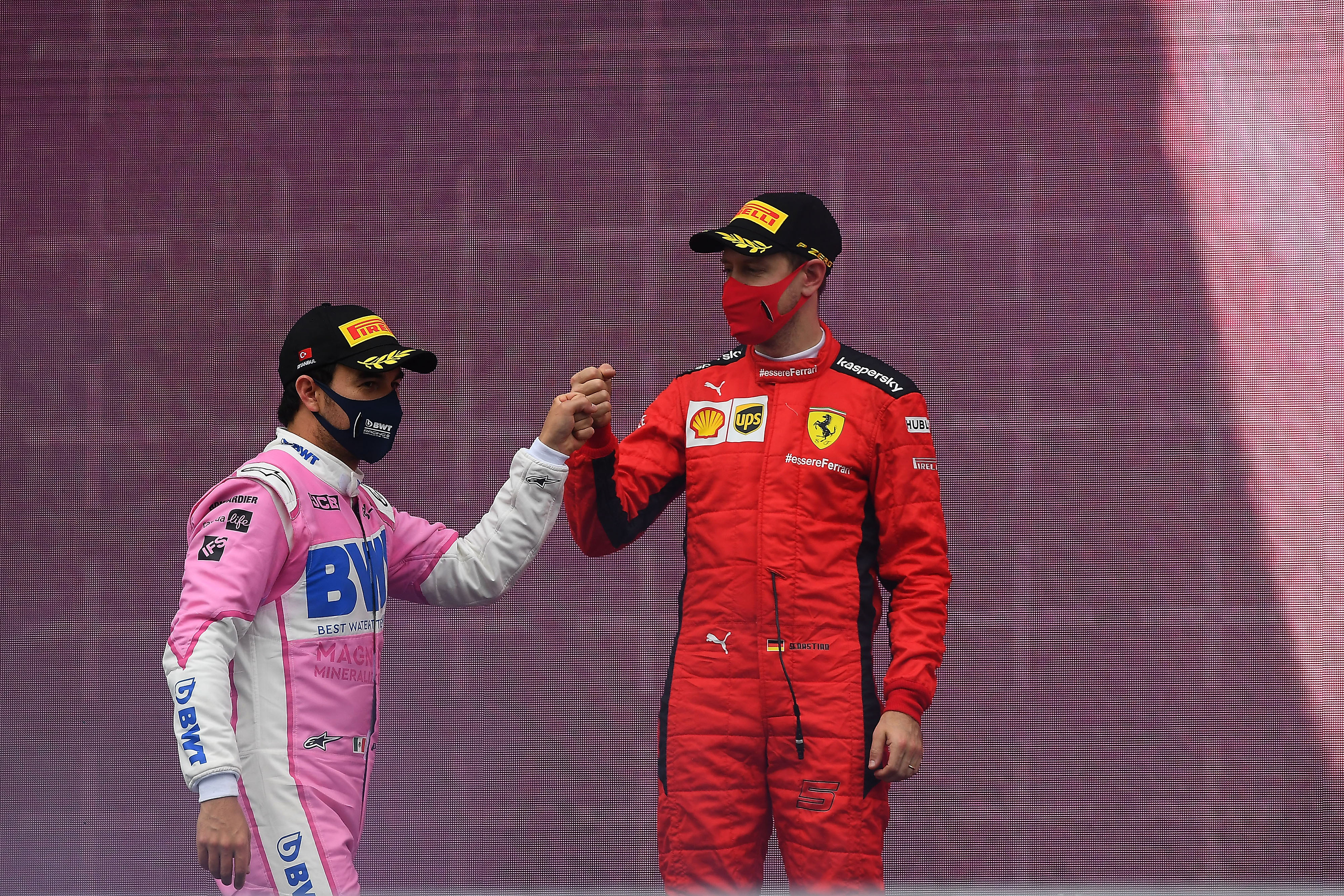
But it was great to see Vettel back on the podium. Nice to see him up there with Hamilton too, given their shared history, in this historic moment.
“With this track and the new surface here, you saw some incredible drivers losing control today,” said the seven-time champ.
“That’s how slippery and difficult the conditions were. This was a big test for me because you know, this was more than racing in the rain… this was ice!
“I don’t remember having an ice race before. I feel like I achieved something different today.
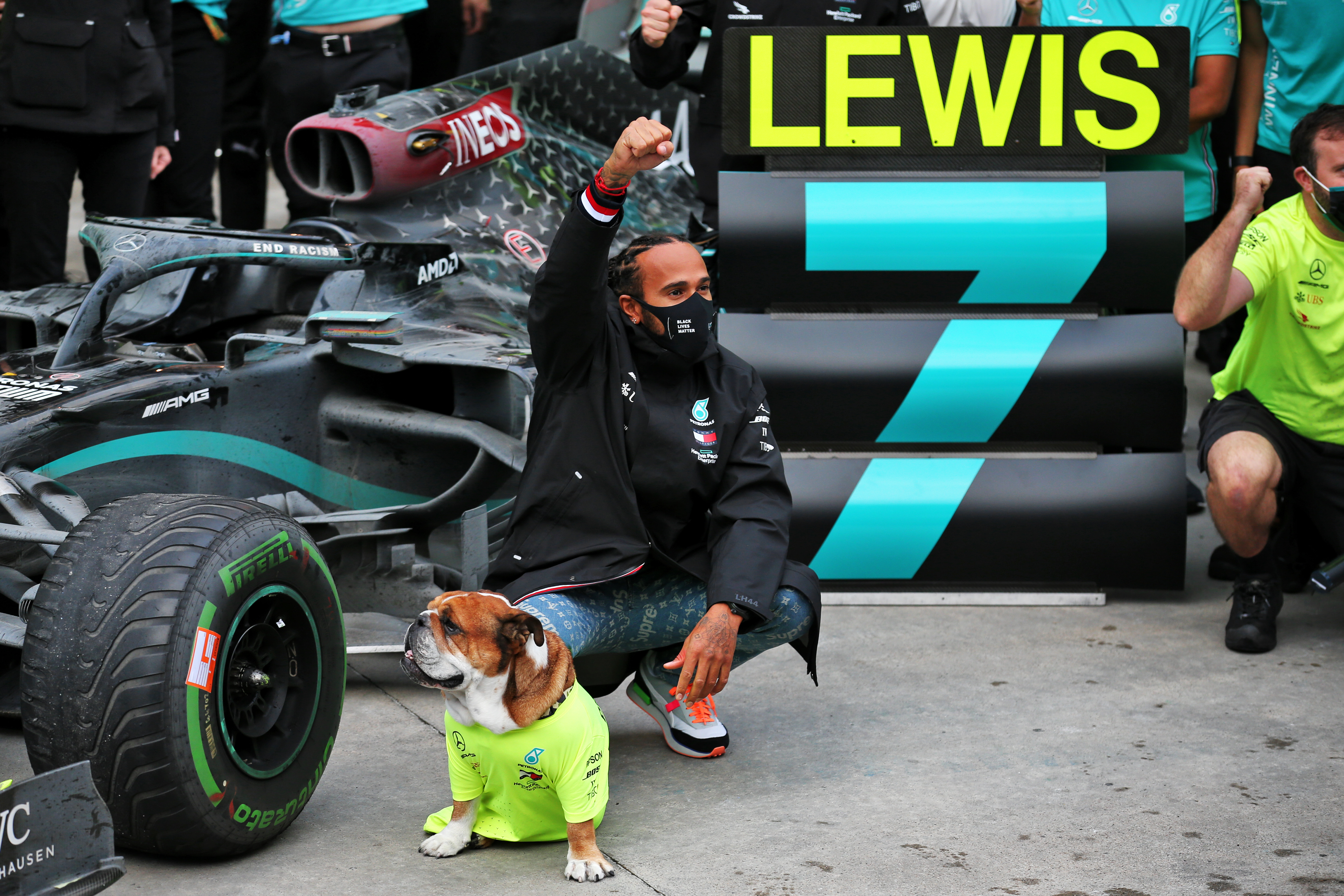
“The more I race, the more I feel like I’m getting better. I think I’m understanding myself more. I know what I want from the car. I know what buttons to push.
“During a race I’m constantly tweaking my driving style. It’s like trying to find the right numbers to put together to be able to get you through the corners in a way that is faster than everyone else.
“That mathematics, that algorithm never seems to stop.”








